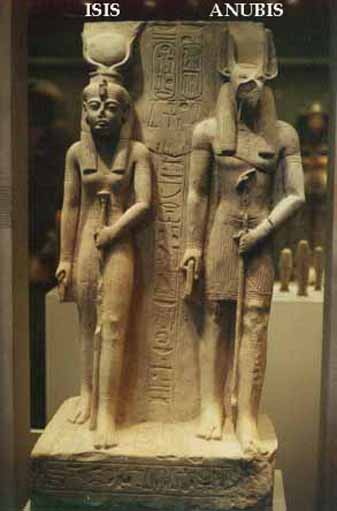 |
Isis is the feminine archetype for creation - the goddess of fertility and motherhood. She has gone by many names and played many roles in history and mythology - as goddess and female creator.
Her name literally means female of throne, i.e. Queen of the throne. Her original headdress was an empty throne chair belonging to her murdered husband, Osiris. As the personification of the throne, she was an important source of the Pharaoh's power. Her cult was popular throughout Egypt, but the most important sanctuaries were at Giza and at Behbeit El-Hagar in the Nile delta.
The hieroglyph for her name originally used meant (female) of flesh, i.e. mortal, and she may simply have represented deified, real, queens. The most commonly used name for this deity, Isis, is a Greek corruption of the Egyptian name; and its pronunciation as eye-sis is a further corruption by English speakers.
The true Egyptian pronunciation is unknown, as Egyptian hieroglyphs only recorded consonants, and left out most of the vowels. The Egyptian hieroglyphics for her name are commonly transliterated as jst; as a convenience, Egyptlogists pronounce that as ee-set.
|
Other symbols linked with her include the tat,

knot or buckle, and the sustrum (rattle)
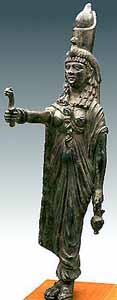
Titles
In the Book of the Dead, Isis was described as She who gives birth to heaven and earth, knows the orphan, knows the widow, seeks justice for the poor, and shelter for the weak. Some of Isis' many other titles were:
- Queen of Heaven,
- Mother of the Gods,
- The One Who is All,
- Lady of Green Crops,
- The Brilliant One in the Sky,
- Her Latin name was Stella Maris, or Star of the Sea,
- Great Lady of Magic,
- goddess of magic, fertility, nature, motherhood,
- underworld Mistress of the House of Life,
- She Who Knows How To Make Right Use of the Heart,
- Light-Giver of Heaven,
- Lady of the Words of Power,
- Moon Shining Over the Sea.
Isis later had an important cult in the Greco-Roman world, with sanctuaries at Delos and Pompeii. To the Greeks she was known as Demeter - to the Romans as Ceres - though she played other goddess roles in all ancient civilizations.
The symbol of Isis in the heavens was the star Sept (Sirius), which was greatly beloved because its appearance marked not only the beginning of a new year, but also announced the advance of the Inundation of the Nile, which betokened renewed wealth and prosperity of the country.
Isis was regarded as the companion of Osiris,
whose soul dwelt in the star Sah - Orion.
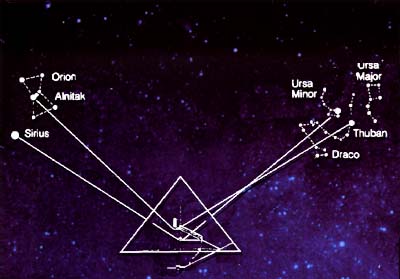
She was the light-giver at this season of the year and was called Khut.
As the mighty earth-goddess her name was Usert.
As the Great Goddess of the Underworld she was Thenenet.
As the power which shot forth the Nile flood, she was Sati, and Sept.
As the embracer of the land and producer of fertility by her waters she was Anqet.
As the producer and giver of life she was Ankhet.
As the goddess of cultivated lands and fields she was Sekhet.
As the goddess of the harvest she was Renenet.
As the goddess of food which was offered to the gods, she was Tcheft, and lived in the Temple of Tchefau.
As the great lady of the Underworld, who assisted in transforming the bodies of the blessed dead into those wherein they were to live in the realm of Osiris, she was Ament - the "hidden" goddess. As Ament she was declared to be the mother of Ra.
In this last capacity she shared with Osiris the attribute of 'giver of life,' and she provided food for the dead as well as for the living.
At a comparatively early period in Egyptian history Isis had absorbed the attributes of all the great primitive goddesses, and of all the local goddesses such as Nekhebet, Uatchet, Net, Bast, Hathor, etc., and she was even identified as the female counterpart of the primeval abyss of water from which sprang all life.
It is manifestly impossible to limit the attributes of Isis, for we have seen that she possesses the powers of a water goddess, an earth goddess, a corn goddess, a star goddess, a queen of the Underworld, and a woman, and that she united in herself one or more of the attributes of all the goddesses of Egypt known to us.
Origins
Her origins are uncertain but are believed to come from the Nile Delta; however unlike other Egyptian deities she did not have a centralised cult at any point throughout her worship. First mentions of Isis date back to the 5th dynasty, but her cult became prominent late in Egyptian history, when it began to absorb the cults of many other goddesses. It eventually spread outside Egypt throughout the Middle East and Europe, with temples to her built as far away as the British Isles. Pockets of her worship remained in Christian Europe as late as the 6th century.
Priesthood
Little information on Egyptian priests of Isis survives; however it is clear there were both male and female priests of her cult throughout her early history. By the Graeco-Roman era, all priestesses of Isis are female. Many of them were healers and midwives, and were said to have many special powers, including dream interpretation and the ability to control the weather by braiding or combing their hair, the latter of which was because the ancient Egyptians considered knots to have magical power.
Worship - Temples
Most Egyptian deities started off as strictly local, and throughout their history retained local centers of worship, with most major cities and towns widely known as the hometowns to their deities. However, no traces of local Isis cults are found; throughout her early history there are also no known temples dedicated to her.
Individual worship of Isis does not begin until as late as the 30th dynasty; until that time Isis was depicted and apparently worshipped in temples of other deities. However, even then Isis is not worshipped individually, but rather together with Horus and Osiris. Temples dedicated specifically to Isis become wide-spread only in the Roman times.
By this period, temples to Isis begin to spread outside of Egypt. In many locations, particularly Byblos, her cult takes over that of worship to the Semitic goddess Astarte, apparently due to the similarity of names and associations.
During the Hellenic era, due to her attributes as a protector, and mother, and the lusty aspect originally from Hathor, she was also made the patron goddess of sailors. Throughout the Graeco-Roman world, Isis becomes one of the most significant of the mystery religions, and many classical writers refer to her temples, cults and rites. The cult of Isis rose to prominence in the Hellenistic world, beginning in the last centuries BC, until it was eventually banned by the Christians in the 6th century.
Despite the Isis mystery cult's growing popularity, there is evidence to suggest that the Isis mysteries were not altogether welcomed by the ruling classes in Rome. Her rites were considered by the princeps Augustus to be "pornographic" and capable of destroying the Roman moral fibre.
Tacitus writes that after Julius Caesar's assassination, a temple in honour of Isis had been decreed; Augustus suspended this, and tried to turn Romans back to the Roman gods who were closely associated with the state. Eventually the Roman emperor Caligula abandoned the Augustan wariness towards Oriental cults, and it was in his reign that the Isiac festival was established in Rome. According to Josephus, Caligula himself donned female garb and took part in the mysteries he instituted, and Isis acquired in the Hellenistic age a "new rank as a leading goddess of the Mediterranean world."
Roman perspectives on cult were syncretic, seeing in a new deity merely local aspects of a familiar one. For many Romans, Egyptian Isis was an aspect of Phrygian Cybele, whose orgiastic rites were long naturalized at Rome, indeed she was known as Isis of Ten Thousand Names.
In the Golden Ass (1st century), Apuleius' goddess Isis is identified with Cybele.
Temples to Isis were also built in Iraq, Greece, Rome, even as far north as England where the remains of a temple were discovered at Hadrian's Wall.
At Philae her worship persisted until the 6th century, long after the wide acceptance of Christianity.
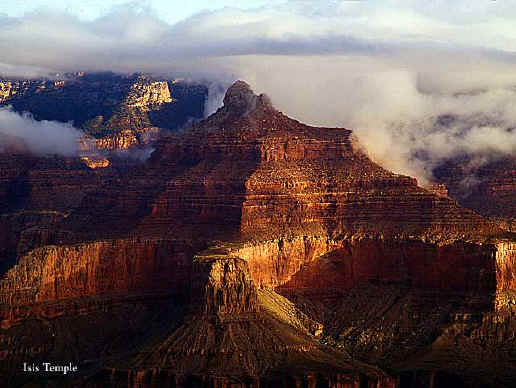
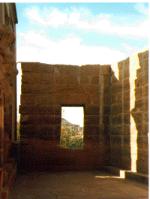
The Isis Temple on Philae was built in the 30th Dynasty on an island in the Nile - originally faced a neighboring island, Biga, which was reserved for the priesthood of Osiris and was believed to be the first land to have emerged from the primordial chaos as well as supposedly being one of the burial places of Osiris.
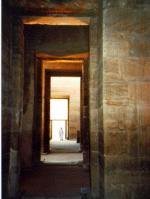
Looking out from the temple sanctuary, or Holy of Holies, where the goddess resides. The sanctuary was thought to be the source of the waters of life and was once separated from the rest of the temple by a curtain.
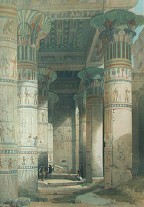
Looking out from the temple sanctuary, or Holy of Holies, where the goddess resides. The sanctuary was thought to be the source of the waters of life and was once separated from the rest of the temple by a curtain.
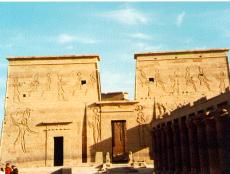
The first pylon (the wall surrounding the entrance) is 18 metres high and 45 metres wide. The base stones represent the stones which appear as the waters of life recede.The small door in the west section of the pylon leads to the Birth House. At right angles to the pylon is the Gate of Ptolemy. The main portal in the center dates from Nectanebo II.
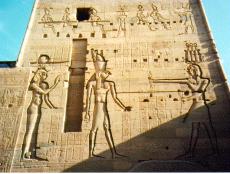
The second pylon shows pharoah (Neos Dionysos) offering sacrifice to Horus and Hathor; in the smaller scenes (above) he offers a wreath to Horus and Nephthys and incense before Osiris, Isis and Horus.
Associations
Because of the association between knots and magical power, a symbol of Isis was the tiet/tyet (meaning welfare/life), also called the Knot of Isis, Buckle of Isis, or the Blood of Isis.
The tiet in many respects resembles an ankh, except that its arms curve down, and in all these cases seems to represent the idea of eternal life/resurrection.
The meaning of Blood of Isis is more obscured, but the tyet was often used as a funerary amulet made of red wood, stone, or glass, so this may have simply been a description of its appearance.
The star Spica (sometimes called Lute Bearer), and the constellation which roughly corresponded to the modern Virgo, appeared at a time of year associated with the harvest of wheat and grain, and thus with fertility gods and goddesses. Consequently they were associated with Hathor, and hence with Isis through her later conflation with Hathor. Isis also assimilated Sopdet, the personification of Sirius, since Sopdet, rising just before the flooding of the Nile, was seen as a bringer of fertility, and so had been identified with Hathor. Sopdet still retained an element of distinct identity, however, as Sirius was quite visibly a star and not living in the underworld - Isis being the wife of Osiris, king of the underworld.
In the duality of our reality - Isis represents our feminine aspects - creation - rebirth - ascension - intuition - psychic abilties - higher chakras- higher frequency virbations - love and compassion. She is the Yin energies - the mother nurturer - the High Priestess - the Goddess of all mythological tales - to other female icons in the mythologies of creation. She is the essence of the feminine energy which is part of us all.
Isis - the iris of the eye - the eye of Horus Isis linked with Sirius - eye of Ra - and the source of creation. Osiris - 'O'=completion of the work of Isis of this level.
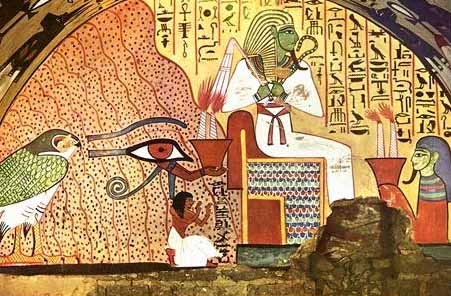
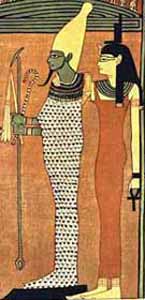
The Osiris Legend
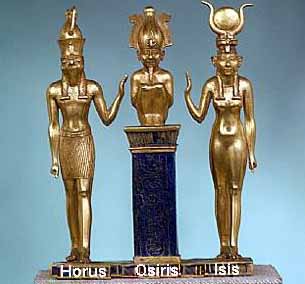
This myth is filled with metaphors based on the creational patterns of Sacred Geometry. You must read beyond what is given to understand the true meaning.
The Legend of Osiris is one of the most ancient myths in Egypt, and it was central to the ancient Egyptian state religion. The myth establishes Osiris' position as god of the dead and lord of the underworld, and Horus' (and thus all the pharaohs) right to kingship. It also demonstrates the powers and duties of the other major gods as well as setting up the Great Adversary, Set also known as Seth. Yet oddly enough, we have yet to find a complete version of the story. What we have has been cobbled together over many years from many different documents and sources.
According to Niel Gaiman the legend is one of the Great Stories. The Great Stories are part of the core human experience and never change except in the most superficial ways. They defy any attempts to rewrite them with drastic changes, always returning to their original forms. The setting might be modified depending on who's telling it, the characters have different names, but fundamentally, it's still the same story. A version of the Osiris myth exists in every culture: the just king murdered by his cruel brother, only to be avenged by the prince who follows in his father's footsteps. Sometimes the dead king is rewarded for his upright ways and gains great reward in the next life. We find its echoes in nearby civilizations such as the Greeks and Romans, in far-off Japan and China, in Christianity, even in Shakespeare, where the avenging prince is named Hamlet.
In the beginning, there was the mighty god Ra and his wife Nut. Nut was in love with the god Geb. When Ra found out about this union he was furious. In his rage, he forbid Nut to have children on any of the 360 days that currently made up the year. Nut was very sad.
She called on her friend, Thoth, to help her. He knew that Ra's curse must be fulfilled, but he had an idea. Thoth engaged the moon goddess, Silene, in a wager. At the time, Silene's light (the moon) rivaled the light of Ra (the sun). Thoth was victorious, he was rewarded with one seventh of Silene's light. This is why the moon now wanes each month. Thoth took this light and added five days to the calender, bringing the year from 360 days to 365. This gave Nut 5 days on which she could have children, while at the same time obeying Ra's commandment. On the first of these days, Nut gave birth to Osiris. On the second day Horus was born, Seth on the third, Isis the fourth, and Nephthys on the fifth day. At the time of Osiris' birth, a loud voice was heard all over the world, saying, "The lord of all the Earth is born."
Osiris grew and became a mighty king. He went about the job of civilizing his people. He taught them agriculture and animal husbandry. He gave them a code of laws to live by and showed them the proper ways in which to worship the gods. Egypt became a mighty land under his kind and gentle rule. His subjects gladly worshiped the ground on which he walked. When Egypt was civilized, Osiris left to bring his teachings to other lands. While Osiris was away, he left his wife, Isis, in charge. She ruled the country in the same fashion. But Osiris had an enemy, his bitter and jealous brother, Seth.
Seth began scheming against the great king. He aligned himself with Aso, the queen of Ethiopia, and 72 other conspirators. But nothing could be done while Isis ruled the country, her authority was unquestionable.
Upon Osiris' return, an evil plot was put into motion. Seth secretly acquired the measurements of Osiris and began having a wonderfully decorated box built to fit those measurements. When the box was finished, Seth had a great feast to which he invited Osiris and the 72 conspirators. Having absolutely no evil in him, Osiris suspected nothing.

When the feasting was done, Seth had the box brought out. He offered it as a gift to anyone whom the box fit. One at a time they tried to fit into the box until it was Osiris' turn. He layed in the box suspecting nothing. The conspirators slammed the lid, nailed it closed, and poured molten lead in the seam to seal his fate. They threw the great chest into the Nile river. Osiris was never seen again, walking in the land of the living.
Isis was not afraid of Seth. She searched all of the Nile for the box containing her beloved husband. Finally she found it, lodged in a tamarisk bush that had turned into a mighty tree, for the power of Osiris still was in him, though he lay dead. She tore open the box and wept over the lifeless body of Osiris.
She carried the box back to Egypt and placed it in the house of the gods. She changed herself into a bird and flew about his body, singing a song of mourning. Then she perched upon him and cast a spell. The spirit of dead Osiris entered her and she did conceive and bear a son whose destiny it would be to avenge his father. She called the child Horus, and hid him on an island far away from the gaze of his uncle Seth.
She then went to Thoth who knows all secrets, and implored his help. She asked him for magic that could bring Osiris back to life. Thoth, lord of knowledge, who brought himself into being by speaking his name, searched through his magic. He knew that Osiris' spirit had departed his body and was lost. To restore Osiris, Thoth had to remake him so that his spirit would recognize him and rejoin. Thoth and Isis together created the Ritual of Life, that which allows us to live forever when we die. But before Thoth could work the magic, cruel Seth discovered them. He stole the body of Osiris and tore it into 14 pieces, scattering them throughout Egypt. He was sure that Osiris would never be reborn.
Yet Isis would not despair. She implored the help of her sister Nephthys, kind Nephthys, to guide her and help her find the pieces of Osiris. Long did they search, bringing each piece to Thoth that he might work magic upon it. When all the pieces were together, Thoth went to Anubis, lord of the dead. Anubis sewed the pieces back together, washed the entrails of Osiris, embalmed him wrapped him in linen, and cast the Ritual of Life. When Osiris' mouth was opened, his spirit reentered him and he lived again.

Yet nothing that has died, not even a god, may dwell in the land of the living. Osiris went to Duat, the abode of the dead. Anubis yielded the throne to him and he became the lord of the dead. There he stands in judgment over the souls of the dead. He commends the just to the Blessed Land, but the wicked he condemns to be devoured by Ammit.
When Seth heard that Osiris lived again he was wroth, but his anger waned, for he knew that Osiris could never return to the land of the living. Without Osiris, Set believed he would sit on the throne of the gods for all time. Yet on his island, Horus, the son of Osiris and Isis, grew to manhood and strength.
The depiction of the seated holding or suckling the child Horus
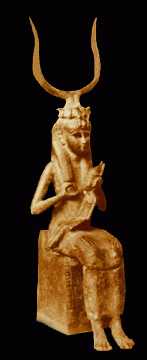
is reminiscent of the iconography of Mary and Jesus.
Many believe Mary, mother of Jesus, was an incarnation of Isis.
Set sent many serpents and demons to kill Horus, but he defeated them. When he was ready, his mother Isis gave him great magic to use against Seth, and Thoth gave him a magic knife.
Horus sought out Seth and challenged him for the throne. Seth and Horus fought for many days, but in the end Horus defeated Seth and castrated him. But Horus, merciful Horus, would not kill Seth, for to spill the blood of his uncle would make him no better than he. Seth maintained his claim to the throne, and Horus lay claim himself as the son of Osiris. The gods began to fight amongst another, those who supported Horus and those who supported Set. Banebdjetet leaped into the middle and demanded that the gods end this struggle peacefully or Maat would be imbalanced further. He told the gods to seek the council of Neith. Neith, warlike though wise in council, told them that Horus was the rightful heir to the throne. Horus cast Seth into the darkness where he lives to this day.
And so it is that Horus watches over us while we live, and gives guidance to the Pharaoh while he lives, and his father Osiris watches over us in the next life. So it is that the gods are at peace. So it is that Set, wicked Seth, eternally strives for revenge, battling Horus at every turn.
When Horus wins, Maat is upheld and the world is at peace.
When Seth wins, the world is in turmoil. But we know that dark times do not last forever, and the bright rays of Horus will shine over us again.
In the last days, Horus and Seth will fight one last time for the world. Horus will defeat Seth forever, and Osiris will be able to return to this world.
On that day, the Day of Awakening, all the tombs shall open and the just dead shall live again as we do, and all sorrow shall pass away forever.
It is said that this battle of good verses evil still rages, but some day, Horus will be victorious and on that day, Osiris will return to rule the world.
Magic
Isis was a magician, possibly the archetype for the high priestess of the tarot. She learned her magic from Thoth, although according to some legends she obtained her powers from Ra himself by tricking him into revealing his name to her, thus acquiring his full magical knowledge.
In order to resurrect Osiris for the purpose of having the child Horus, it was necessary for Isis to learn magic, and so it was that Isis tricked Ra (i.e. Amun-Ra/Atum-Ra) into telling her his "secret name", by getting a snake to bite and poison him, so that he would use his "secret name" to survive. This aspect becomes central in magic spells, and Isis is often implored to use the true name of Re while performing rituals. By the late Egyptian history, Isis becomes the most important, and most powerful magical deity of the Egyptian pantheon.
Magic is central to the entire mythology of Isis; arguably more so than any other Egyptian deity.In consequence of her deeply magical nature, Isis also became a goddess of magic. The prior goddess to hold the quadrupole roles of healer, protector of the canopic jars, protector of marriage, and goddess of magic, Serket, became considered an aspect of her. Thus it is not surprising that Isis had a central role in Egyptian magic spells and ritual, especially those of protection and healing. In many spells, she is also completely even merged with Horus, where invocations of Isis are supposed to automatically involve Horus' powers as well.
Depictions
In art, originally Isis was pictured as a woman wearing a long sheath dress and crowned with the hieroglyphic sign for a seat, sometimes holding a lotus, as a sycamore tree.
After her assimilation of Hathor, Isis' headdress is replaced with that of Hathor: the horns of a cow on her head, and the solar disc between them. She was also sometimes symbolised by a cow, or a cow's head.
Usually, she was depicted with her son, the great god Horus, with a crown and a vulture, and sometimes as a kite bird flying above Osiris's body.
Isis is most often seen holding only the generic ankh sign and a simple staff, but is sometimes seen with Hathor's attributes, the sistrum rattle and the crescent moon shaped menat necklace.
Isis is often depicted with a throne on her head and with wings, meaning ascension, linked with the Phoenix the female bird of resurrection.
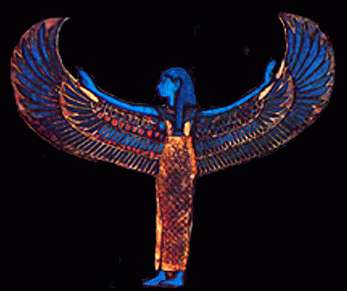
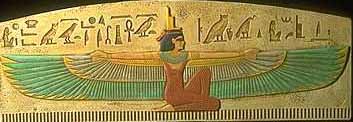

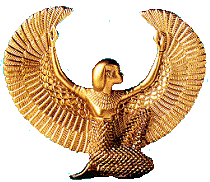
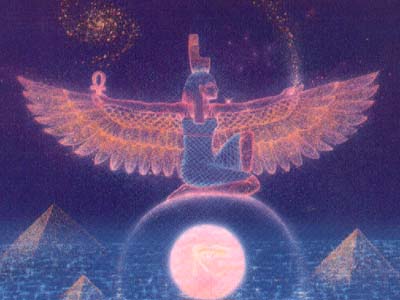
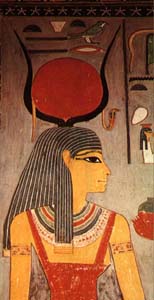
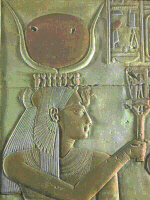

Discuss and comment on article |
Return to Unexplained Mysteries
|























